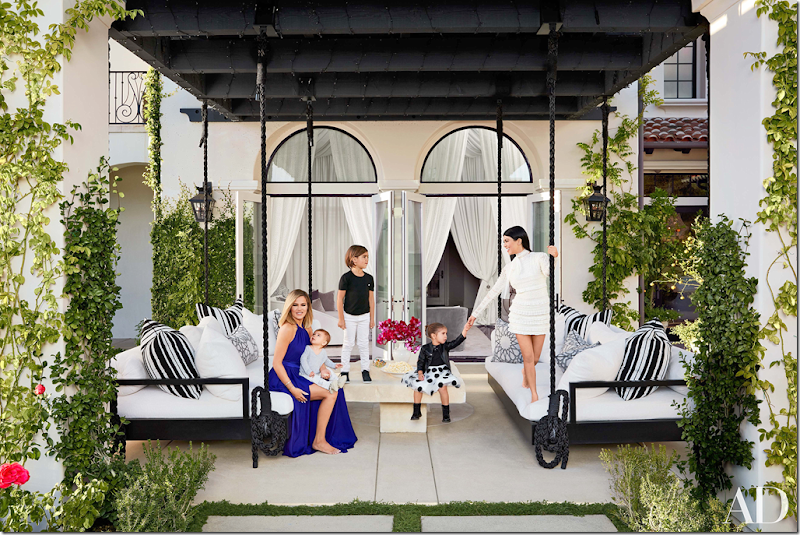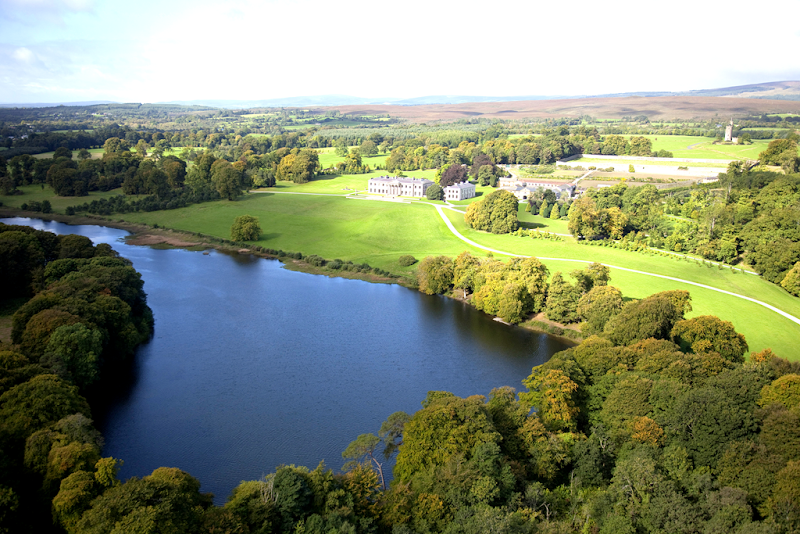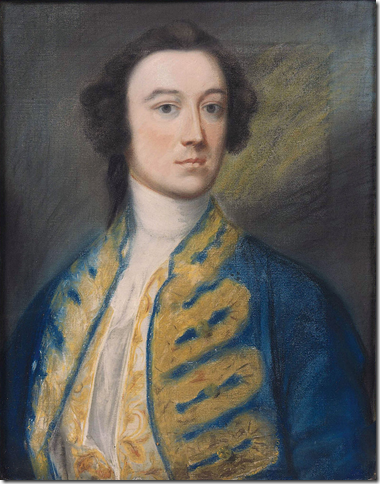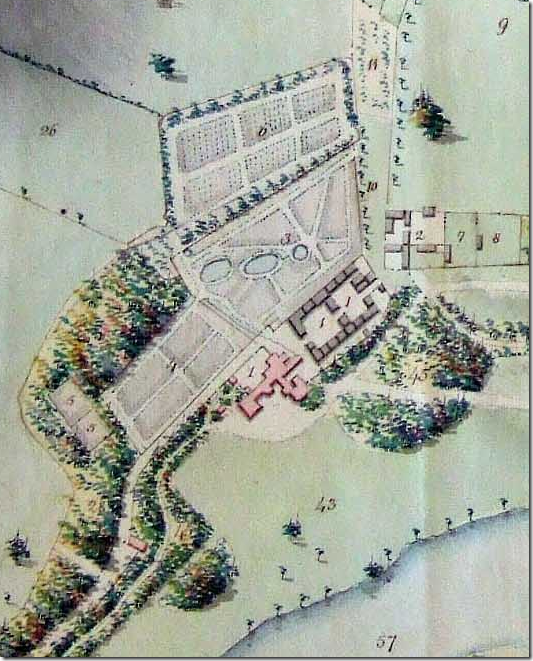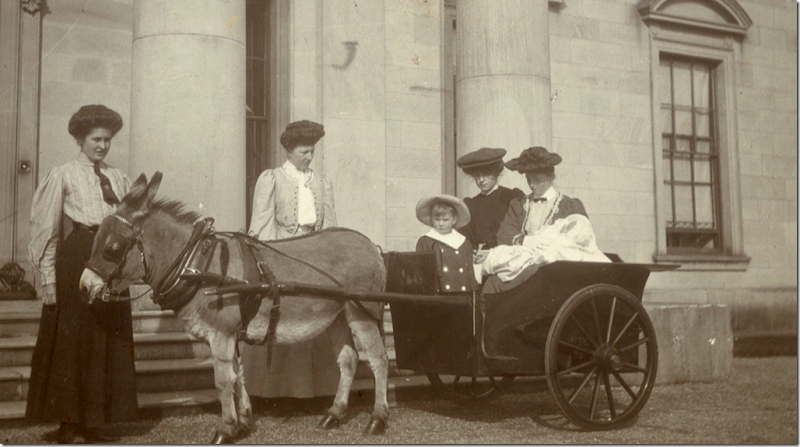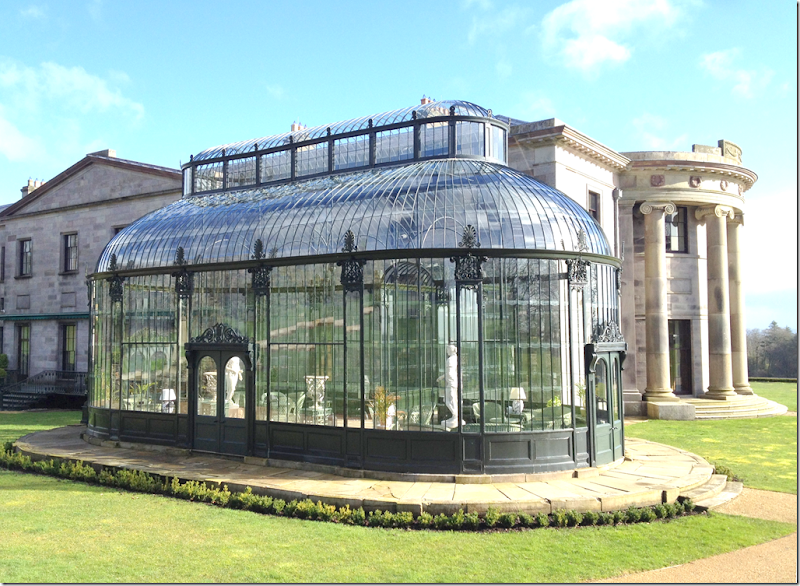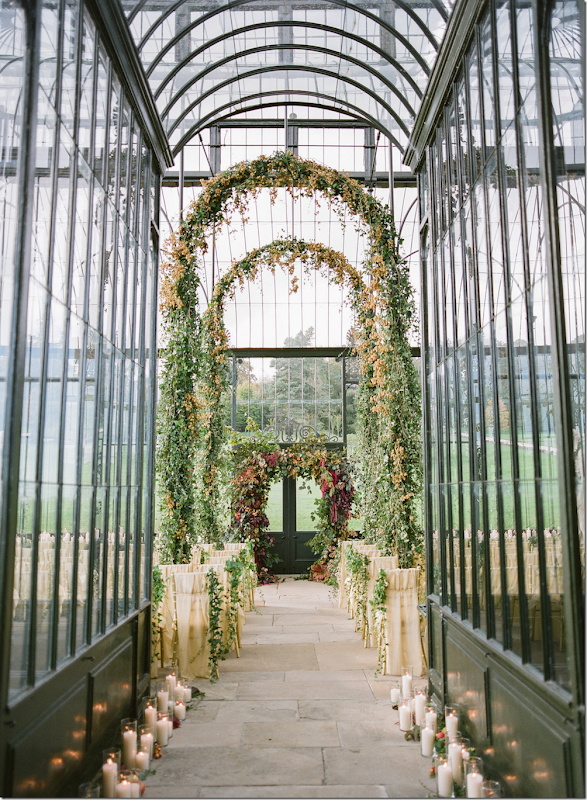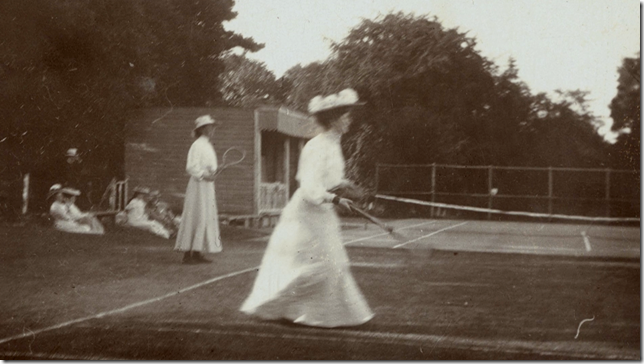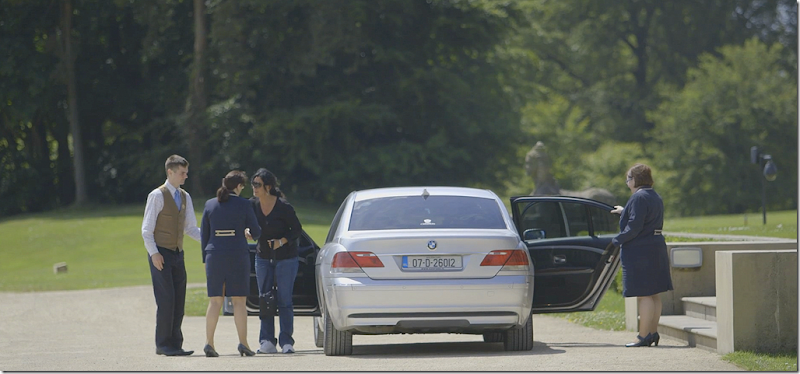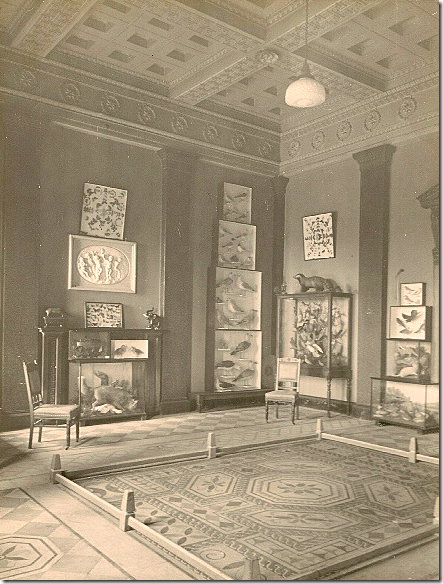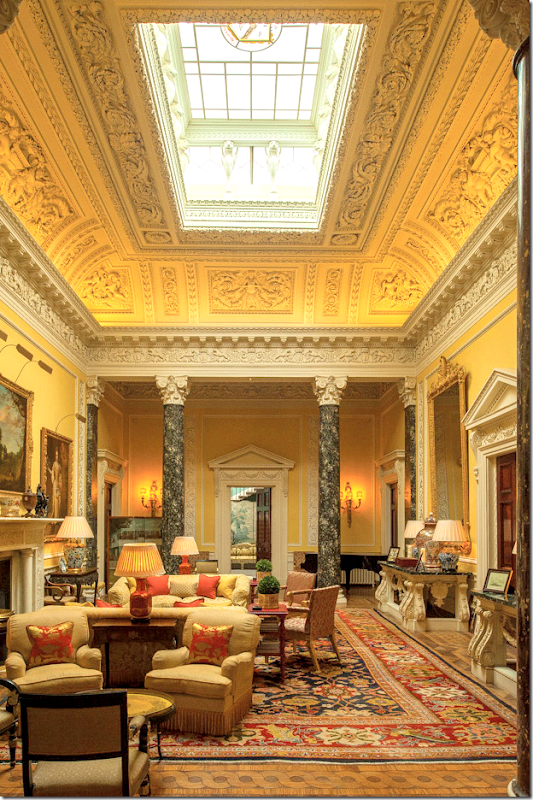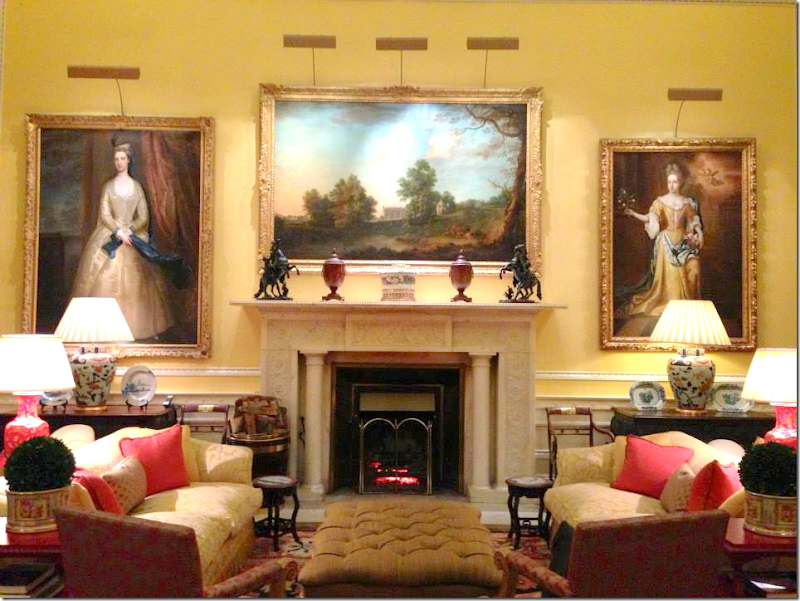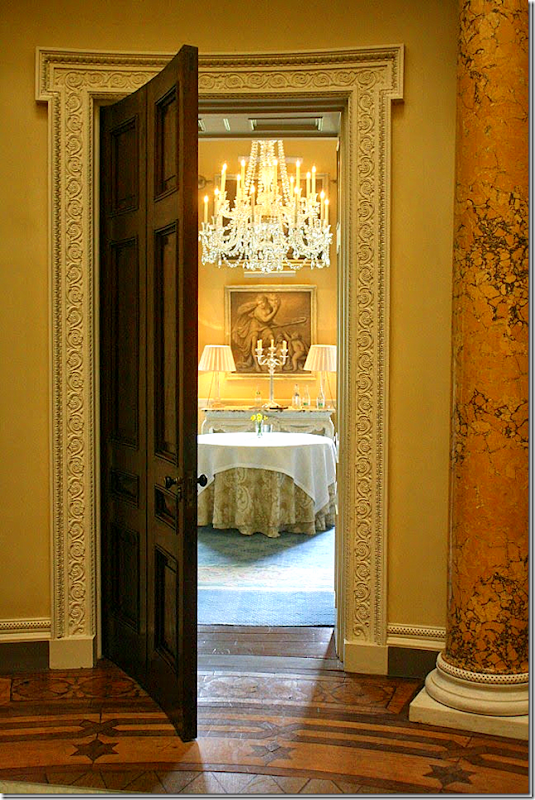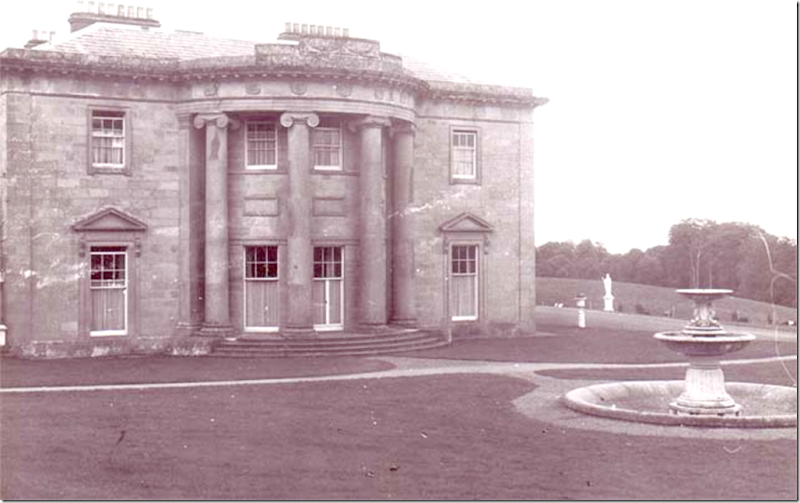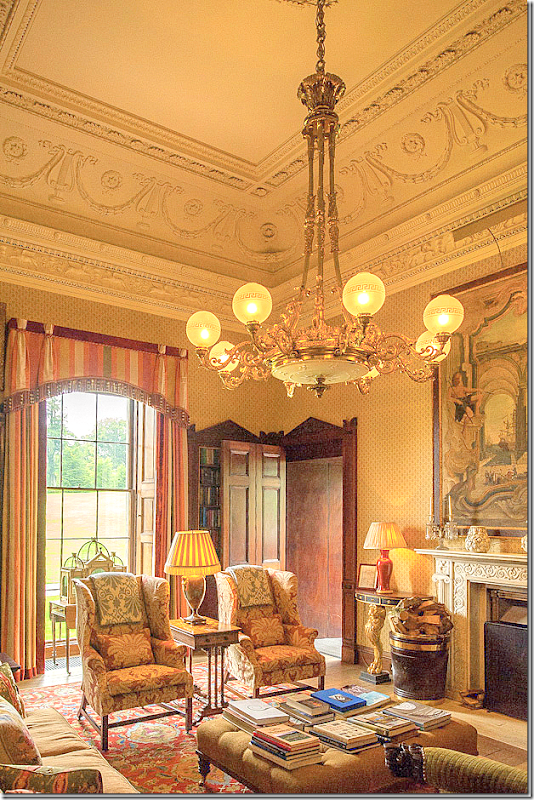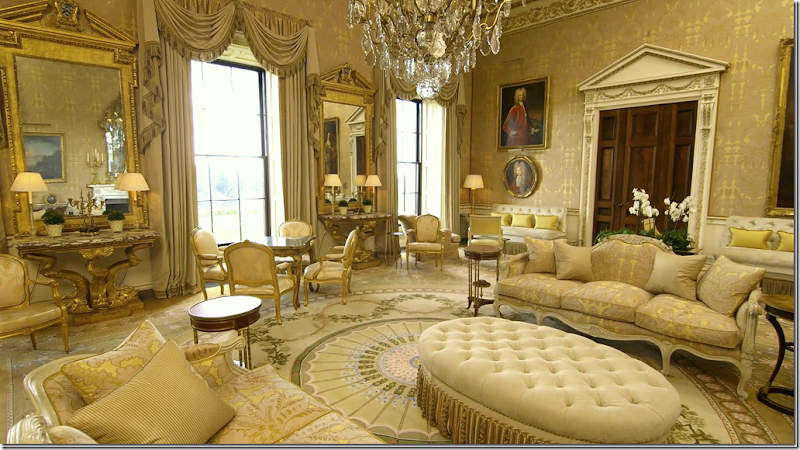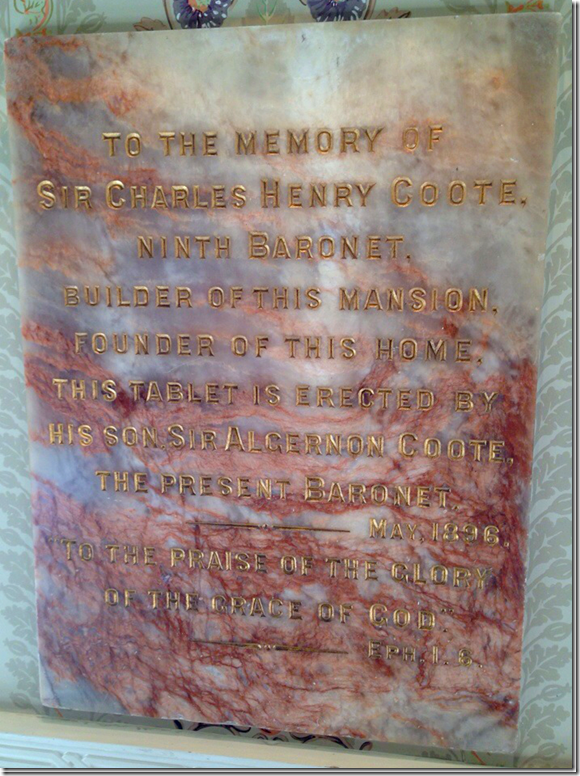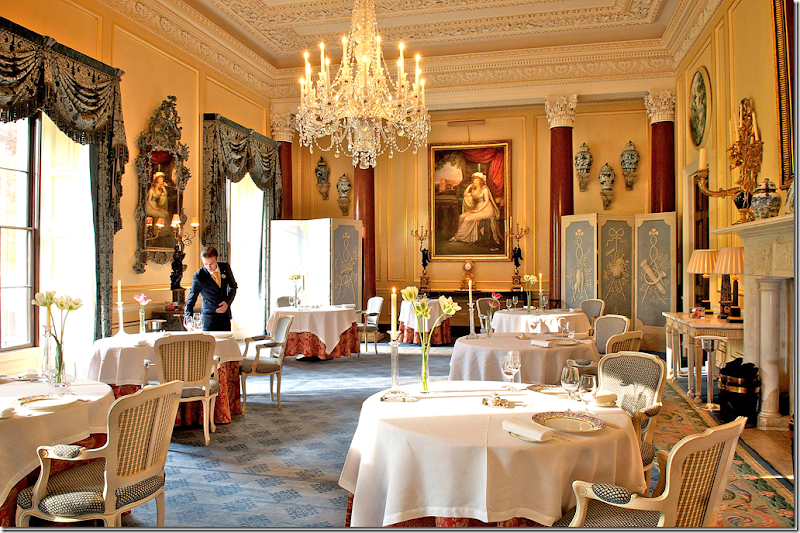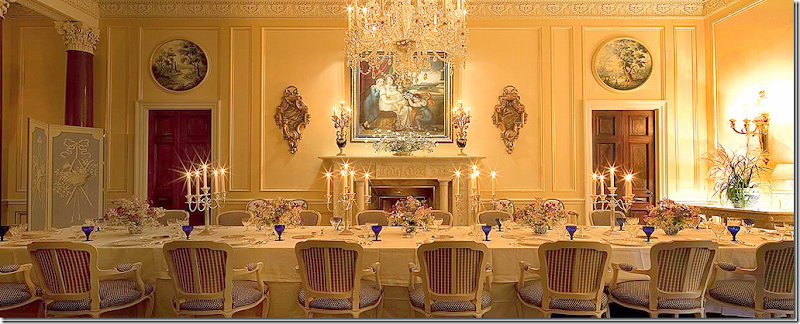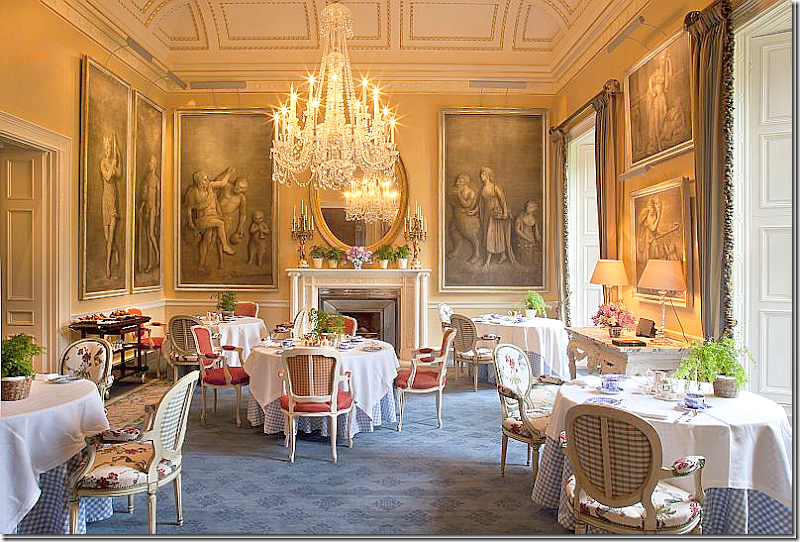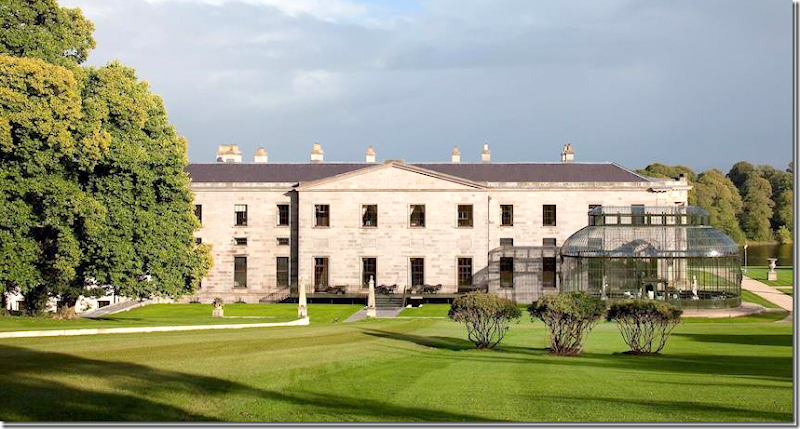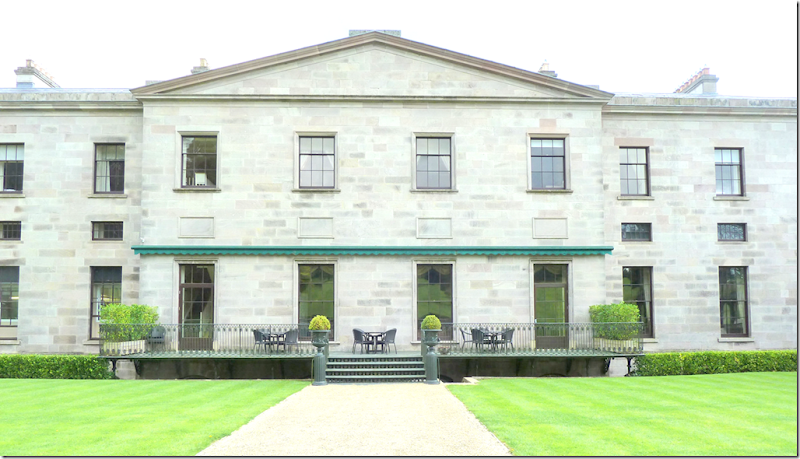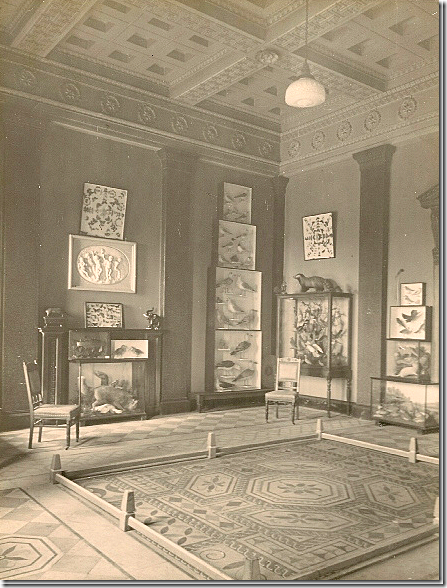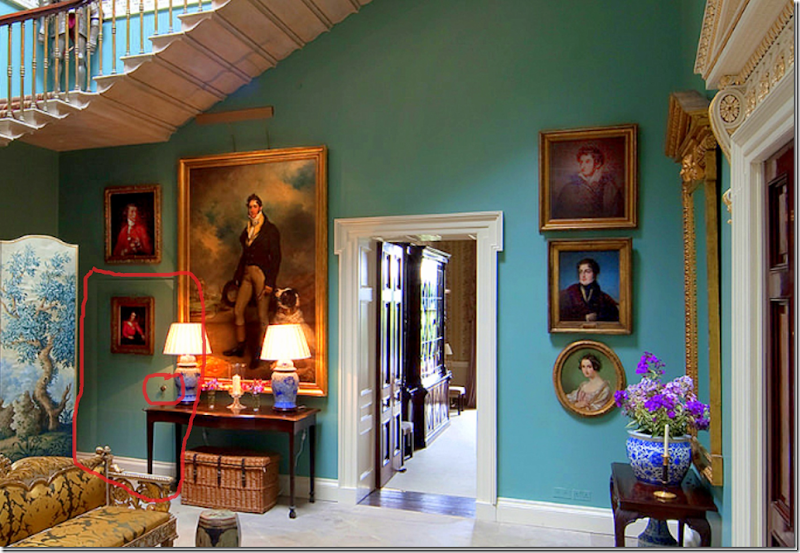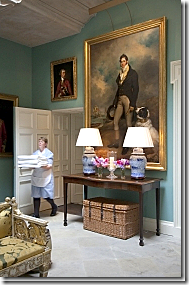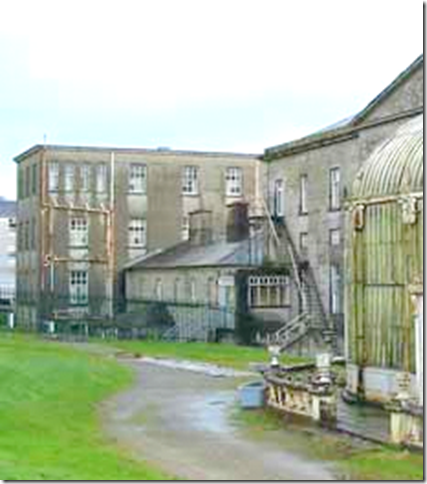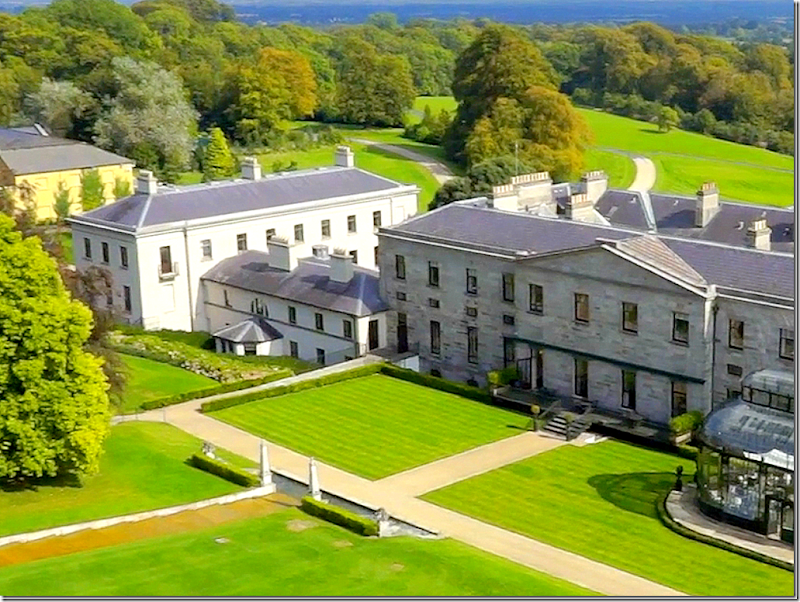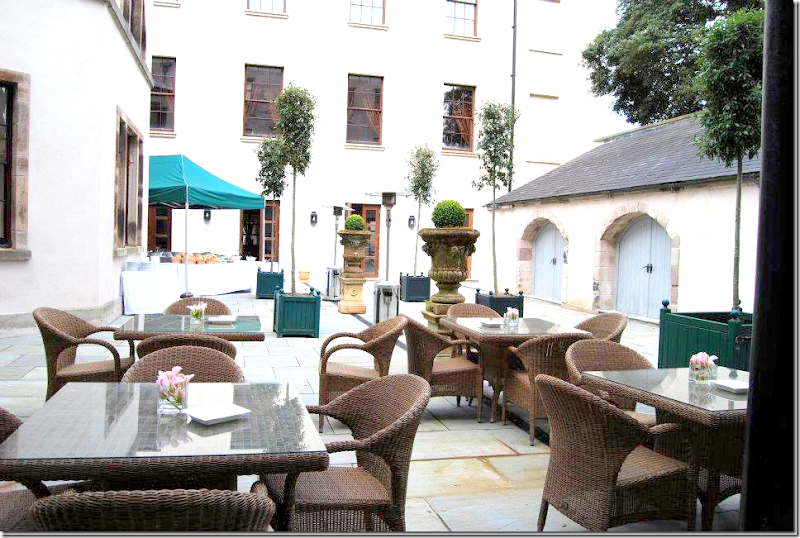A reminder – “Segreto Vignettes” – Leslie’s brand new book is available for preorder. HERE
Part One: When you finish reading this story – read Part Two by clicking on the “Older Posts” button at the end of the page.
Last week, celebrity designer Martyn Lawrence Bullard took time off from decorating all the Kardashians mac mansions to attend a wedding in Bath. England. He then jetted over to Ireland for a stay at the most luxurious hotel – the Ballyfin Demesne. Lucky fellow. I mean, decorating for all those Kardashians!!!!
Seriously, imagine how much fun a decorator can have when Khloe and Kourtney and Kendall and Kylie are all klients? I konfess, I’m a fan.
But, I digress.
I’m not stalking Martyn’s vacation plans this summer. Of course not! He posted all the pictures of his days off on his very public Instagram and when he publicizes photos of his hotel suite at the Ballyfin – you can’t help but sit up and take notice. It’s a gorgeous room.
I’ve been lusting over the Ballyfin since it opened in 2011 and I’ll probably never get to check it off my bucket list, so, inspired by Martyn Lawrence Bullard, I thought we’d all tour the Irish hotel together! It’s been called the most gorgeous, the most luxurious, the most incredible, the most cozy place to stay in all of Ireland and I think you will agree.
The Ballyfin Demesne, once a country house, is now a hotel with just 20 rooms. During your stay there, all you have to worry about are the guests in the other 19 rooms who might disturb your fantasies that you are actually the lady of the house ala Downton Abbey.
The Ballyfin Demesne strives hard to make its guests feel at home, as opposed to feeling like they are staying at a hotel. They have been very successful in this approach that permeates every aspect of their management style. It’s hard to leave the Ballyfin and return to reality. Many who come are either repeat visitors, or they want to be. This much respected hotel has a very well-deserved good reputation.
And, speaking of the Kardashians, Kanye and Kim are rumored to have spent part of their honeymoon at Ballyfin. The list of stars who have been guests is of course not publicized. The hotel expected that most visitors would be from the stars from the states, but to the surprise of the owners, Americans are not the only guests, the Irish are also filling up the rooms.
Once I started researching this hotel – I realized that the story is not only about what it is today – but what this building once was – which is a family house. A big, beautiful family house, to be sure, but still – a family house that became a boarding school and then slowly deteriorated over the years.The story of this house, its incredible 8 year restoration and how it was saved to become a 5 star hotel is what makes it all the more interesting.
Ballyfin DemasneThe lands of the estate were once known simply as Bally-fin which mean “town of Fionn” - named after one of its earliest known inhabitant, Fionn Mac Cumhaill the leader of the Fianna (don’t ask me!)
Demesne means “land attached to a manor.” In Ireland, usually an estate, or a demesne (pronounced da-maine,) will have some sort of fence that marks its boundaries. At Ballyfin, its ancient stone walls still surround parts of the estate.
The 614 acre Ballyfin Demesne located in County Laois,was owned by a succession of families, including the Poles. Above is William Pole, who with his wife Sarah, created the lake and the much heralded natural landscape both still so important to the beauty of Ballyfin today. William and Sarah also extended the house that they had inherited from his uncle, another William. That house had been built in 1720, replacing an old Tudor castle previously there.
Above, in 1794, the house the Poles built at Ballyfin, is seen from across the lake. This house was torn down to make room for the present mansion.
This map from early 1800s shows the original Pole mansion in pink, with the stables and farm buildings behind it. Read about the map HERE.
Later, it was another Pole, William Wellesley-Pole, who sold the Ballyfin estate to the Coote family. It was Sir Charles Coote who demolished the Pole’s house and built the grand house that is still standing today. The site of this new house was moved 200 ft to the west of the Pole’s house, away from the stable blocks.
Sir Charles Henry Coote, the first Coote to live on Ballyfin and the one who built the house that still stands today. He paid for the lavish house with part of his inheritance including the profits from the sale of a town that he owned. Sir Charles was considered one of the richest men in Ireland, along with being one of its largest landowner.
These are the plans for the current house at Ballyfin. The Regency house was designed by father and son Irish architects Sir Richard and William Morrison, who in 1820 were hired by Sir Charles Coote. The house the Morrisons designed is considered one the most important examples of 19th century neo-classical architecture in Ireland. It has a 13 bay facade which is broken by a portico with giant Ionic columns.
The side elevation – shows the Library - which runs the entire width of the house from front to back. The bay window is the central part of the Library, which is divided into three bays.
The house is quite large, it originally measured 35,000 sq. feet. It has two stories, with a basement and a mezzanine level.
The Coote Family owned the Ballyfin estate for 100 years, where they lived in genteel luxury, as evidenced by the numerous photos of the family at play.
At the front entrance of Ballyfin in the late 1800s. The nannies with their charges as the mothers look on.
With the coming of Ireland’s Independence, money became an issue for the large landowners, and the Cootes were no exception.
They sold their house to the Patrician Brothers in 1920 for just 10,000 pounds. The Brothers then turned the estate into a popular, but austere boarding school for nearby boys. In 1928, the Brothers added a dormitory onto the back of the house, where the students lived.
The estate proved too expensive for the Patrician Brothers to keep it in good condition and it gradually fell into great disrepair. Meanwhile, a couple from Chicago – Fred Krehbiel, a billionaire, and his Irish wife Kay who hails from County Kerry - wanted to find a grand house in Ireland and turn it into a small hotel. They partnered with Landscape Designer and historian Jim Reynolds, who approached the Brothers with a proposal to buy the estate. The Brothers agreed, and the sale was brokered – with the provision that the school would stay open until the final class graduated.
The restoration was a huge endeavor and very expensive, there are estimates that it cost over $60 million. It looks it too – when you see all the chandeliers and fine art and antiques inside! The owners don’t expect to ever get their investment back. It’s a labor of love to them.
The story of Fred and his wife Kay and how the Chicago couple came to own this Irish estate is very interesting. Krehbiel, in his 70s, is considered a Renaissance man, intensely interested in the fine arts, antiques, silver, porcelains – and more, especially when the finery is Irish. His fascination with large houses began as a young man when he visited a classmate’s relatives during graduate school in England. The house he stayed in had 60 rooms, but the family only lived in five, typical of the cash strapped aristocracy.
Krehbiel recalls that visit: “It was an immense pile, like Ballyfin, and I had seen pictures and movies and all, but I hadn’t really experienced it. They were not living so grandly. They were trying to hold it together, but it was fascinating to see.”
Having been bit by the old mansion bug, Krehbiel spent his life harboring a dream of turning an old house into a boutique hotel. Ballyfin Demasne fit the bill.
Now that they are hoteliers, the Krehbiels spend a week each month in Ireland while the rest of the time they are at home in Chicago. Most interesting is that they don’t live at Ballyfin – their own house in Ireland is actually 2 1/2 hours away!! I would love to see THAT house!
BEFORE: This shows the estate after it became a boarding school. There is the original house and the taller dormitory that the Brothers built behind the house for the students. Later, during the restoration – the top floor of the dormitory was taken off so that the house and the dorm were the same height as opposed to having the dorm looming over the house as it once did.
BEFORE: The view from the opposite side. The large double quadrangle farm buildings behind the dorm were turned into schoolrooms for the boys.
TODAY: Here you can see that the mansion and the dorm are now the same height. Originally there were 15 hotel rooms, all but one, located in the mansion. Last year, five more rooms were added – in the old dormitory. Also in the old dorm is the indoor swimming pool and the ballroom.
DURING: In order to renovate the mansion and estate, a major restoration was undertaken, which lasted over eight years - longer than it took to build the original house. First, the roof needed to be completely fixed in order to stop the leaks which had already caused much damage and dry rot to the house. A temporary roof was built over the original roof while it was repaired.
Another early issue was the stone facade which was crumbling. Between repairing the roof and the facade – these jobs alone took over two years.
BEFORE: The conservatory, which was built for the Coots family in 1855 by Richard Turner, was also in total disrepair. It had to be dismantled piece by piece and sent to England to be repaired. The Conservatory was part of the original plan by Architects Morrison, but for some reason, it was put on hold and not built until years later.
During: The Patrician Brothers took great pride in Ballyfin and tried very hard to keep the estate in good condition – but with their meager bank account, it was an impossible task. In the end it was a blessing that the Cootes sold the house to the Brothers. They kept it as it was and made very little changes to the house itself – which was a godsend to new owners.
After it was repaired, the conservatory was put back together at the estate and then reglazed. Before the glass was fitted, the new iron shell was shaky – it is actually the glass panes that stabilize the structure. Each piece of glass is a curved, unique size – no two pieces are alike. Also – the conservatory used to be cream, and it was said to look like a wedding cake. Today, it is painted a dark green.
After: And how it looks today – on its new stone floor and all the glass installed, along with the landscaping. The winter garden is used for breakfast, lunch and tea, along with parties and weddings.
The conservatory is reached through a hidden door in a bookcase in the library. Here you can see that conservatory is connected to the house via a glass hall.
The hall leading from the library to the conservatory is dressed with lit candles for an afternoon wedding. You can really see the green paint here.
It’s called the Winter Garden, but really – it’s so pretty inside during the summer!
Besides the house, the estate needed attention too. The 30 acre lake was created in the 1700s, along with much of the natural landscaping by owner William Pole and his wife Sarah. Later, the famous designer John Webb (no relation, unfortunately!!!) was hired to improve the estate’s landscape. What is most amazing is the lake is man-made and was completely dug out by hand – a back breaking endeavor, to be sure. Old forestry blocked the views and had to be reduced. New trees were planted in a more natural formation.
This temple and water cascade looks old, but it is the brainchild of Jim Reynolds. It was erected on the back side of the house to add interest to that part of the estate. The fountain gives the rooms on the west side a more beautiful vista, along with the addition of the lovely sound of its babbling water. Most people are shocked to learn the cascade and temple are new to the estate.
The cascade and temple becomes a focal point when seen from inside the mansion.
The story behind this stone tower is quite interesting. It is actually a folly, built during the great potato famine in order to put local men to work, instead of them having to accept handouts. It is located on the highest point of the estate and has 95 internal steps, along with a fireplace at its top and a bathroom at the bottom! A moat circles the tower. The hotel has several carriages which guests use to tour the estate.
During the restoration, the top of the tower was glassed in so that hikers can comfortably (and warmly) spend time up there while looking at the view.
The hotel sets up a lunch at the top of the tower. Apparently, it’s also a favorite spot for getting engaged.
During Edwardian times, the Coote family at the tennis court with its club house.
Today, a winter view of the renovated tennis court along with its restored club house.
These gates lead to the one of the two walled gardens, now blooming again with spring and summer flowers. Besides the flower gardens, there are vegetable gardens where food for the hotel is grown.
The grounds are filled with special points of interest for the guests, like these two walled gardens. Additionally, there are follies, a grotto, an aviary, an ice house, and a fernery, among other spots to visit. Guests can use bikes or horses to get around the estate, or they may choose to go hiking. There are also all the usual country sports such as fishing, shooting, archery, and tennis. And of course there is a full spa and exercise room. What there is not is a golf course – a point of pride to the hotel whose owners feel it would detract from the beauty of the landscape.
Lunches and teas are set up in the picnic house. Other times – this is used for skeet shooting.
The pineapple fountain is new but Lady Caroline’s yellow aviary is original to the estate and is next in line to be restored.
Before: The entry gates to the estate during the school daze looked rather run down. At the left is the gate house. This one way road leads into the house. The exit gate looks similar to this and has another identical house, which looks like a mini Ballyfin.
Today: The original gates to the estate were updated with new signage and the gates were painted dark green.
The aerial view of the drive up to the house. The driveway was actually moved a bit so that you don’t see the house at all until the final bend at the end of the drive when it finally comes into view to great effect.
The first view of the house and the lake on the left.
At dawn, the house takes on a golden hue.
Before: The house before it was sold to the Brothers. The drive was a packed dirt road, and there was no landscaping.
Today. The same exact view shows all the restoration. There is a new drive, with new stairs that lead to the house, along with the sculptures on each side of the house. Everything is serene here. The owner even paid to have a tunnel constructed so that delivery trucks can arrive at the basement without being seen by the hotel guests.
Here you can see the tunnel being built behind the house. Amazing.
Here’s a very crude floor plan I drew of the house’s first floor with the dorm, the old kitchen, and the courtyard all to the right of the main house. The second level floor plan is further below.
The house was designed using classical proportions and is very symmetrical with enfilades between the reception rooms. The center rooms: the rotunda, the saloon, and the stairhall – together are the same size as the library. The dining room and the gold drawing room are also the same size. The new owners were thankful that the Cootes had sold the house to the Brothers because they basically left the house alone and didn’t change much at all – besides building the dormitory. All the mahogany doors were intact, as were the mahogany framed windows.
The beauty of the house remained, it just needed to be cleaned up and refreshed – it was all still there, almost 200 years later.
The nighttime view of the facade, with its 13 bays and 4 columns. The two windows on the ground floor at the very left and very right are blacked out because they are covered up and are non working inside the house.
The staff comes out to greet each guest, sometimes standing in a line like at Downton Abbey. There are just 40 staff members – and they quickly learn each guest’s name and favorite drink. Most are Irish and some are former students of the school – a few employees actually worked on the restoration. All are hired to make guests feel at home. The employees aren’t hired because they majored in hospitality in college. Instead, they are at Ballyfin to create a certain atmosphere of warmth.
Before: An early view of the Entry Hall. The floor of the entry is made of mosaics that were brought back from Italy in 1822. Was this makeshift fence built to prevent the students from walking on the tiles? Notice all the natural specimens on the walls.
Today: From the front door view to the Entry Hall – the door leads to the Grand Saloon where the fireplace is blazing – let’s head to this room next. Here you can immediately see an enfilade – one of the more important design principles of the house.
Today, the tile floor is restored and the room is painted a warm terracotta. Over the door are the horns of an Irish Elk, extinct for over 10,000 years. Through the door is the Whispering Room. Be sure to notice the ceilings in all the reception rooms. The stuccowork is all original to the house.
On the left side of the entry hall is the fireplace and a rack of wellies for the guests.
The interiors were designed by Colin Orchard, the well known designer to the upper crust of England, and the partner of William Yeoward. Orchard worked many years at Colefax & Fowler before starting his own firm. You might remember when I featured his work on a gorgeous estate in New Zealand HERE.
An aerial view of the roof – showing the 3 skylights in the center reception rooms, one above each of the 3 middle rooms: The Rotunda, Grand Saloon, and the Stairhall.
Before: Under the Patricians, the Grand Saloon was very dark and was painted green with gilt trim.
The Grand Saloon is in the middle of the house and most rooms lead off from it. Since it sits in the middle of the house, there are no windows and it was once quite dark. There is a large skylight, but at the time the house was built – colored glass was used. Colin Orchard changed out the colored glass with clear glass in order to bring daylight into this central room:
Today: The Saloon has three sections – divided off by two sets of Scagliola Corinthian columns and pilasters. This room has the most beautiful stuccowork, along with an absolutely incredible marquetry wood floor. Today, the Saloon is painted a bright yellow with white stuccowork.
The view of the incredible skylight and stuccowork.When the house was built – seven packing cases were sent in 1821 from the artist Gaspare Gabrielli’s agency in Italy filled with matching chimneypieces with Bacchanalian friezes that are now in the Saloon and Dining Room along with the Roman mosaic floor now laid in the Entry Hall.
Here you can see the beautiful, restored skylight with the clear glass. Through the open door is the Stairway.
Close-up of the wood marquetry floor found in the Grand Saloon. Through the years, small pieces of the floor popped off and were carefully stored in a box by the Brothers. When the floor was restored – all the missing pieces were put back in the parquet floor.
The house is filled with masses of fine art work, some antique, some contemporary. The owners have been collecting Irish art for decades and their bounty has finally found a home. To fill in the rooms, the owners and Orchard bought from auction houses. Everything is first class.
In one corner sits the piano – the room is so large, you don’t even see it. The floor looks so beautiful here.
The two mirrors above the consoles were designed by Robert Adam and made by Thomas Chippendale in 1763 and are some of the most prized antiques found in the house.
Nighttime view. The door between the two consoles leads to the Entrance Hall. Notice how beautiful the doors and architrave are.
The house is so pretty at night with the candles and the art lit up.
Through this open door is the Rotunda. Let’s go there next.
Before: During the Patricians time, the Rotunda was a riot of circus colors.
Today: The Rotunda is painted a soft yellow to blend with its 8 marble Ionic columns. The floor has an inlaid design based on the Lion Court of the Alhambra Palace, in Granada. The Rotunda’s columns are modeled after the Erechtheion in Athens, while the dome’s oculus is reminiscent of the Pantheon.
The pattern of the floor is seen here – with the stars on the border. Stars are a decorative theme throughout the house. Through the open door is the Library. Other rooms that lead off the Rotunda are the Breakfast Room, the Saloon, and the Gold Drawing Room. Again, the enfilade is important. This view starts at the stairhall and goes all the way through to the bay window in the library.
The view from the Rotunda to the Breakfast Room with its chandelier perfectly centered.
A view of the oculus in the Rotunda, inspired by the Parthenon.
Look at the detail in the stained glass. The workmanship in the house is incredible. More stars around the skylight.
Let’s head to the Library:The library is the largest room – it runs along the left side or south side from the front of the house to the back, where the Conservatory is.
Before: The fountain was supposed to be aligned with the bay window in the library. It would then be seen from the stairhall, to the saloon, to the rotunda, to the library. The fountain was installed when Sir Cootes was out of town.
Unfortunately, it was several feet off center and since it was so heavy, it remained that way for almost 200 years or so.
Today: The fountain was moved and it is now centered on the middle bay window. Finally!
A watercolor of the library in 1850 by The Marquis de Massigny who was married to Sir Charles and Lady Caroline Coote’s daughter, Caroline. There is a suite in the hotel named after the Marquis.
And a photograph taken of the library when owned by the last of the Coote family. The room looks very much as it did in 1850. Large white marble statuary was placed around the room. A table sat in the central bay – in front of the large window. Large, gilt framed paintings were hung above all the bookcases.
Before: Restoration begins on the Patrician Brothers’ decor – red on the center walls, with green on the other walls. The stuccowork is gilded along with green accent paint.
Before: Centuries worth of wax needed to be stripped from the wood floors. Notice how thick that wax is after almost 200 years!! Yuck!!!!
Today: The largest room in the house is divided into three areas – the center section aligns with the bay window. The walls are papered in an Owen Jones pattern. Notice that the original bookcases are inset into the walls and do no project out. The glass doors protect the books from dust and the sun. The furniture is covered in green, yellow and terracotta fabrics. Notice the beautiful black Scagliola columns and pilasters. Colin Orchard used three antique rugs in the room. There is a fireplace at each end of the room.
The view on the opposite side of the library. Each bay has a gasolier over it. Love that architectural model.
Notice the antique bench. Incredible! The antiques that the Krehbiels bought for the house are just beautiful. It really makes it look like a home, not a hotel filled with reproductions.
The gorgeous mahogany bookcases and door. The house is noted for its marble columns imported from Italy, the solid San Domingo mahogany doors throughout, and the custom stuccowork – all of which remained in the house, virtually untouched through the years.
And the view towards the right side of the library. A closeup of the amazing antique gasolier – one of three in the room. This one is from the London’s Royal Academy of Arts.
Each book in the library has a bookplate that states: “Consider it the vilest sin to steal a book from Ballyfin.”
The center section overlooks the side view out the bay window.
This sofa is an antique, as are the side tables.
Here, the hidden bookcase door to the Conservatory is open, so you can get a glimpse of how it works. Notice all the details here, this is a hotel? Piles of books on the ottoman, comforters over the backs of the wing chairs, barrelsful of wood for the fire, and a birdcage in the window!
Through the mirrored double door, you reach the library.
This door leads to the Gold Drawing Room at the front of the house. Let’s go there next!
This photo shows the Drawing Room as it was when owned by the Cootes. Full of gilded French furniture – the rooms was just as dressy then as it is now. It was originally decorated in 1848 by Gillows and Conifod, of London – Lady Caroline Cootes had it redecorated many years after the house was built. She was just a typical woman, even though she was born in the 1800s!
Before: A tiny photo of the room when it was owned by the Patrician Brothers – in green, with dark wood floors and a center table, along with a large mirror. This is probably left over decor from the Cootes family. The students were never allowed in this room and saw only glimpses of it.
Before: When the Patricians sold the house – this was how the Drawing Room looked. Nothing had changed in 150 years. There were a leak in the roof which unfortunately had caused the damage here. The walls were lined with the same green fabric and gilt molding – which was all removed in the renovation. Notice the curtain rods. These were not reused in the Gold Room – but they showed up in the Costume Room (see more below.) Additionally – the gilt molding on the walls was removed and is now in the Indoor Swimming Pool’s room (see more about this later, too!)
Today: The ceiling was repaired – here is a close up look at the incredibly detail. Notice the gold birds and the musical instruments. More stars!
Today – the room is again done in French antiques. The rug was custom made for the space.
The art work is incredible. Most of the work has an Ireland connection, either the subject is Irish or the artist is. Very detailed tours of the house are given to any guest who is interested. Apparently – most are.
The antique chandelier came from Napoleon’s sister’s house.
I love the tufted banquettes. The walls are covered in a linen/silk fabric. Through the large middle door is the Library. The Rotunda is through the second door.
Against the back wall is the famous oil painting of the Coote children.
At night, the art work really becomes dramatic when lit by its custom spots.
These windows overlook the front of the mansion and the lake.
This door leads to the Grand Saloon.
Next to the Entry Hall is the Whispering Room or the original Morning Room. Due to the coved ceiling’s acoustics, you can hear whispers loudly throughout the room.
The small room has the most gorgeous chandelier. The original portrait of Sir Charles Coote was sold and landed in the United States. It was then auctioned off and made its way back to the house. Underneath is the. plaque commissioned by Coote’s son.
Here is the plaque.
Gorgeous. The wallpaper is from Mauny.
Originally, Sir Coote’s study was reached through a door in this room. Today, his study is now a guest room – the “Sir Charles Coote Room” – the only guest room on the ground floor. Its door is now reached through a hidden one in the Stairhall.
This is the stairhall at the house - Coleshill, Berskhire – designed by Inigo Jones. It was the inspiration for Ballyfin’s ceiling:
The Stairhall, as it looked during the Cootes’ ownership. Filled with paintings and a large sculpture.
Before: During the Patrician Brothers ownership, the Stairhall was a combination of light and dark green with cream trim work.
Today: The Stairhall is now a beautiful shade of Tiffany blue. Above, a large skylight brightens up the room. Through the door is the Whispering Room. And through this other door on the right is the Grand Saloon. I love the way it is decorated – a combination of high, like the antique sofa, and the low, like the basket. It is decorated as if this is really a house, not a hotel.
The new owners purchased a collection of oil paintings of the Cootes family – from the family themselves. Today – these portraits line the walls of the Stairhall. This antique sofa is incredible.
All the paintings hang from a system of brass bars and chains so that no nails go into the walls, which are probably stucco and are impossible to hammer into anyway!
Notice the stucco rosettes – they are incredible! The large round skylight lets sun into this middle room.
The skylight is clear glass.
The butler heads to the Whispering Room.
Before: The dining room and the billiard room were turned into a chapel where the students came twice a day for their Oratory. This is the only time they were allowed in the house – and the only room where they were allowed in!!
Today, the pews are now gone and the room was turned back into the Dining Room. The Billiard Room is now the next door Breakfast Room.
Today, the Dining Room has a large crystal chandelier hanging over it. The door to the kitchen is behind the right screen. And there is the second staircase there too.Decorated in blues, I love the blue & white Irish Delft porcelains on the walls.
Set for a wedding reception with a long table. The room was designed for the long table, but that’s not the best arrangement for hotel guests. Before, the only people allowed on the property were hotel guests. Last year, Ballyfin made a few changes and now they allow diners. Only six diners a night though.
So beautiful – both doors lead to the Grand Saloon.
I love the sconces and the oval medallions over the doors. Colin Orchard said he had a hard time coming up the decor in these two dining rooms – but I think they are so pretty!
The view aligns with the cascading fountain and temple. Outside the windows, one of which is a door, is the terrace where there is outdoor dining. Orchard decided to decorate the room in blues to match the pair of antique French blue mirrors.
Today: The Breakfast Room, once the Billiard Room, is decorated with the series of the grisailles by William van der Hagen. The paintings are now framed.
The room blends with the Dining Room - decorated in blues and rose.
The curtains are much simpler than the Dining Room.
The Coote family sits on the dining terrace – with the iron fence painted white. Love the butlers!
Today, the back of the house, with the terrace in the center section – outside the Dining Room.
Closeup of the terrace. I’m wonder if that green strip is a retractable awning? Notice the two windows to the left which are the kitchen. The outside of these windows look the same size as the rest of the facade, but actually – inside they are smaller. You can see the false bottom and top of the windows.
The kitchen has a large selection of brass pots.
And the small interior kitchen window that fits inside the large outside window frame.
Closeup of the kitchen windows – with the exterior large panes and inside, you can see the true smaller size. Nice trick to keep symmetry to the facade.
The Sir Charles Coote Room was once known as The Writing Room, because this was Coote’s private study. This is the only room on the first floor in the house and this window faces the front lake.
Through the closet is a now hidden staircase that leads down to the basement. Originally you entered this bedroom from the Whispering Room, but today – it is entered through a hidden door in the Stairhall.
Stars on the carpet – a motif found over and over again.
I love the two octagon shaped paintings.
The bathroom is Sir Charles former strong room or his gunnery and its a fireproof brick vault, with a reinforced iron door. Inside, is Lady Caroline’s sarcophagus marble tub, found in an attic – it was hoisted through the formerly barred window and installed in the room, along with a shower. The bathroom overlooks the back courtyard and dormitory.
And there is this charming, tiny fireplace in the bathroom.
Notice the bas relief found over the tub was actually already in the house – a century ago, this time framed.
I looked for days for the hidden door to the suite and couldn’t find it. But here it is – with its tiny doorknob. I assume tall people have to duck to enter the room.
OK, I confess!! Actually, I didn’t find the hidden door! I found this tiny picture showing where the door was!! I’m really loving all the hidden doors.
Before: The old kitchen building and the dorm. Notice how unattractive the dorm is. During the restoration – these two buildings were updated and the dorm was made to look more like the house.
Today. You can see the top floor was removed and the new roof was hipped to look more like the house. It was also painted and there are new chimneys and windows. What was once an eyesore is now an asset.
And from the front. Today, the kitchen is inside the main house and the old kitchen building houses the spa and a guest room. All three buildings look out on a new stone courtyard.
This is the second stone staircase – with wallpaper and an oriental wall hangings. It leads down to the lower floors.
The house – overlooking the courtyard, set up for a party.
Next to the house is the old kitchen building, now the spa and exercise areas.
Looking from the house to the newly restored dormitory. The swimming pool is on the ground floor and on the second floor – you can see the new ballroom with the red curtains.
The bar is located in the basement where the school staff used to eat.
Contemporary Irish artists works are shown in the bar, whose doors open to the courtyard.
There is a full gym and spa in the old kitchen building…but
…I don’t think many people spend a lot of time in the spa at Ballyfin.
The wine cellar can be set for dinner or wine & cheese tastings.
My favorite is the china room – where the walls display a collection of Flora Danica. Private meals are also set up here.
The inside swimming pool is located on the first floor of the dormitory. See the gilt molding on the walls?
All of this molding is from the Gold Drawing Room, which was removed during the restoration. It certainly dresses up the pool!
Above the pool in the dormitory is the ballroom, decorated in red damask wallcovering.
AND, the owners bought the old Chicago Opera wardrobe and provide it to the guests who actually wear the clothes to dinner! Do you recognize the trim on the closets? These are the cornices that were in the Gold Drawing Room – reused here.
OK. I think I would rather die than dress up, but everyone says they love it. I do wonder if Martyn Lawrence Bullard dressed up? Or Kanye???
TO READ PART TWO OF THE BALLYFIN STORY, CLICK ON "OLDER POST" BELOW RIGHT!!


